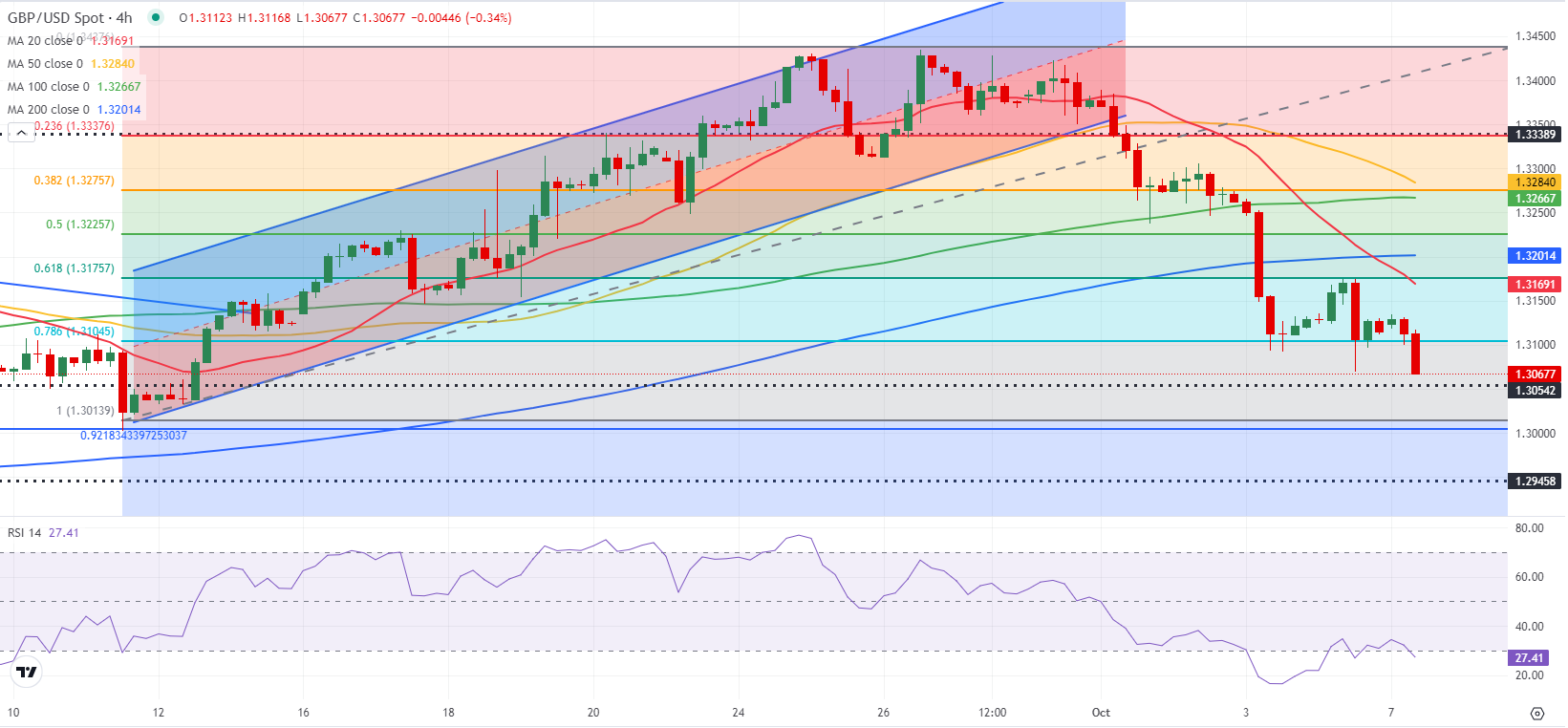- GBP/USD stays under bearish pressure and trades below 1.3100 on Monday.
- The US Dollar preserves its strength following last week's impressive rally.
- The pair could face the next technical support at 1.3050.
GBP/USD registered large losses in the previous week despite holding its ground on Friday. The pair struggles to gain traction at the beginning of the new week and trades below 1.3100.
British Pound PRICE Last 7 days
The table below shows the percentage change of British Pound (GBP) against listed major currencies last 7 days. British Pound was the weakest against the US Dollar.
| USD | EUR | GBP | JPY | CAD | AUD | NZD | CHF | |
|---|---|---|---|---|---|---|---|---|
| USD | 1.83% | 2.31% | 4.29% | 0.62% | 1.74% | 3.19% | 1.98% | |
| EUR | -1.83% | 0.48% | 2.41% | -1.15% | -0.02% | 1.37% | 0.24% | |
| GBP | -2.31% | -0.48% | 2.04% | -1.63% | -0.50% | 0.88% | -0.24% | |
| JPY | -4.29% | -2.41% | -2.04% | -3.45% | -2.50% | -1.02% | -2.14% | |
| CAD | -0.62% | 1.15% | 1.63% | 3.45% | 1.16% | 2.55% | 1.41% | |
| AUD | -1.74% | 0.02% | 0.50% | 2.50% | -1.16% | 1.39% | 0.26% | |
| NZD | -3.19% | -1.37% | -0.88% | 1.02% | -2.55% | -1.39% | -1.14% | |
| CHF | -1.98% | -0.24% | 0.24% | 2.14% | -1.41% | -0.26% | 1.14% |
The heat map shows percentage changes of major currencies against each other. The base currency is picked from the left column, while the quote currency is picked from the top row. For example, if you pick the British Pound from the left column and move along the horizontal line to the US Dollar, the percentage change displayed in the box will represent GBP (base)/USD (quote).
GBP/USD declined sharply on Thursday, pressured by dovish comments from Bank of England (BoE) Governor Andrew Bailey. Although the pair staged a rebound in the European session on Friday after BoE Chief Economist Huw Pill adopted a more cautious tone regarding further policy easing, it failed to stretch higher as the upbeat US employment data boosted the US Dollar (USD).
Nonfarm Payrolls in the US increased by 254,000 in September, surpassing the market estimate of 140,000 by a wide margin, the US Bureau of Labor Statistics reported on Friday. Furthermore, the Unemployment Rate edged lower to 4.1% from 4.2% in the same period, while the Labor Force Participation stood unchanged at 62.7%.
In the absence of high-impact macroeconomic data releases, the negative shift seen in risk mood, as reflected by falling US stock index futures, helps the USD stay resilient against its peers and doesn't allow the pair to start retracing the previous week's slide.
Investors will pay close attention to comments from Federal Reserve (Fed) policymakers in the second half of the day. Currently, the CME FedWatch Tool shows that markets are nearly fully pricing in a 25 basis points (bps) rate cut at the November policy meeting. Hence, the USD could have a hard time gathering further strength even if Fed officials note that another large rate cut won't be needed.
GBP/USD Technical Analysis
The Relative Strength Index (RSI) indicator on the 4-hour chart stays slightly below 30 after holding above that level on Friday, suggesting that buyers refrain from committing to an extended technical correction.
On the downside, 1.3050 (static level) aligns as immediate support before 1.3000 (round level, static level) and 1.2940 (static level). In case GBP/USD rises above 1.3100 (Fibonacci 78.6% retracement level of the latest uptrend) and starts using this level as support, 1.3170 (Fibonacci 61.8% retracement) and 1.3200 (200-period Simple Moving Average) could be seen as next resistance levels.
Pound Sterling FAQs
The Pound Sterling (GBP) is the oldest currency in the world (886 AD) and the official currency of the United Kingdom. It is the fourth most traded unit for foreign exchange (FX) in the world, accounting for 12% of all transactions, averaging $630 billion a day, according to 2022 data. Its key trading pairs are GBP/USD, also known as ‘Cable’, which accounts for 11% of FX, GBP/JPY, or the ‘Dragon’ as it is known by traders (3%), and EUR/GBP (2%). The Pound Sterling is issued by the Bank of England (BoE).
The single most important factor influencing the value of the Pound Sterling is monetary policy decided by the Bank of England. The BoE bases its decisions on whether it has achieved its primary goal of “price stability” – a steady inflation rate of around 2%. Its primary tool for achieving this is the adjustment of interest rates. When inflation is too high, the BoE will try to rein it in by raising interest rates, making it more expensive for people and businesses to access credit. This is generally positive for GBP, as higher interest rates make the UK a more attractive place for global investors to park their money. When inflation falls too low it is a sign economic growth is slowing. In this scenario, the BoE will consider lowering interest rates to cheapen credit so businesses will borrow more to invest in growth-generating projects.
Data releases gauge the health of the economy and can impact the value of the Pound Sterling. Indicators such as GDP, Manufacturing and Services PMIs, and employment can all influence the direction of the GBP. A strong economy is good for Sterling. Not only does it attract more foreign investment but it may encourage the BoE to put up interest rates, which will directly strengthen GBP. Otherwise, if economic data is weak, the Pound Sterling is likely to fall.
Another significant data release for the Pound Sterling is the Trade Balance. This indicator measures the difference between what a country earns from its exports and what it spends on imports over a given period. If a country produces highly sought-after exports, its currency will benefit purely from the extra demand created from foreign buyers seeking to purchase these goods. Therefore, a positive net Trade Balance strengthens a currency and vice versa for a negative balance.
Information on these pages contains forward-looking statements that involve risks and uncertainties. Markets and instruments profiled on this page are for informational purposes only and should not in any way come across as a recommendation to buy or sell in these assets. You should do your own thorough research before making any investment decisions. FXStreet does not in any way guarantee that this information is free from mistakes, errors, or material misstatements. It also does not guarantee that this information is of a timely nature. Investing in Open Markets involves a great deal of risk, including the loss of all or a portion of your investment, as well as emotional distress. All risks, losses and costs associated with investing, including total loss of principal, are your responsibility. The views and opinions expressed in this article are those of the authors and do not necessarily reflect the official policy or position of FXStreet nor its advertisers. The author will not be held responsible for information that is found at the end of links posted on this page.
If not otherwise explicitly mentioned in the body of the article, at the time of writing, the author has no position in any stock mentioned in this article and no business relationship with any company mentioned. The author has not received compensation for writing this article, other than from FXStreet.
FXStreet and the author do not provide personalized recommendations. The author makes no representations as to the accuracy, completeness, or suitability of this information. FXStreet and the author will not be liable for any errors, omissions or any losses, injuries or damages arising from this information and its display or use. Errors and omissions excepted.
The author and FXStreet are not registered investment advisors and nothing in this article is intended to be investment advice.
Recommended Content
Editors’ Picks

AUD/USD holds lower ground below 0.6350 after dismal Australian data
AUD/USD keeps its offered tone intact below 0.6350 in Wednesday's Asian trading, undermined by below forecasts Australian Constuction Output and monthly CPI data. The data fan more RBA rate cut expectations. Risk-off flows and renewed US Dollar demand also add to the weight on the Aussie.

USD/JPY: Rebound gathers steam to near 149.50
USD/JPY is extending the rebound to near 149.50 in Asian trading on Wednesday. The pair tracks the upswing in the US Dollar and the US Treasury bond yields, fuelled by the US House passage of the Republican Budget plan, advancing Trump's tax plans.

Gold buyers jump back amid tariff uncertainty
Gold price struggles to build on Tuesday’s rebound in the Asian session on Wednesday. Gold buyers try their luck as safe-haven flows return on US President Donald Trump’s tariff uncertainty and weak US economic prospects.

Strategy stock dips as Bitcoin price crashes below $90K, sparking concerns of forced liquidation
Strategy witnessed an 11% stock decline on Tuesday, stirred by Bitcoin's market's plunge below $90,000 and fueling speculations of a forced liquidation for the company.

Five fundamentals for the week: Fallout from German vote, Fed's favorite figure stand out Premium
Statements, not facts, are set to dominate the last week of February. Further fallout from Germany's elections and new comments from Trump on trade may overshadow most figures –but not the Fed's favorite inflation figure.

The Best brokers to trade EUR/USD
SPONSORED Discover the top brokers for trading EUR/USD in 2025. Our list features brokers with competitive spreads, fast execution, and powerful platforms. Whether you're a beginner or an expert, find the right partner to navigate the dynamic Forex market.
